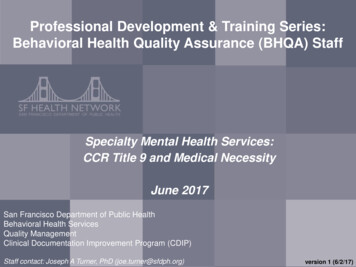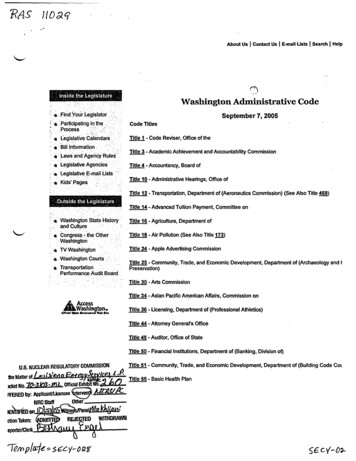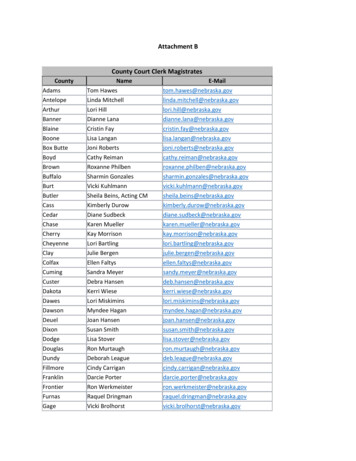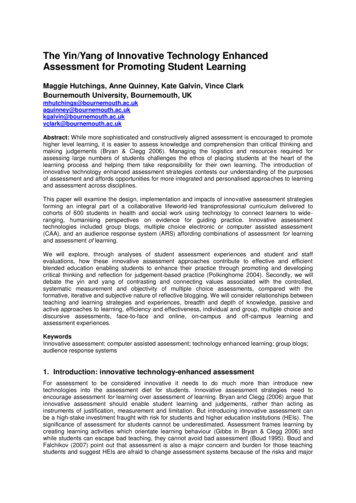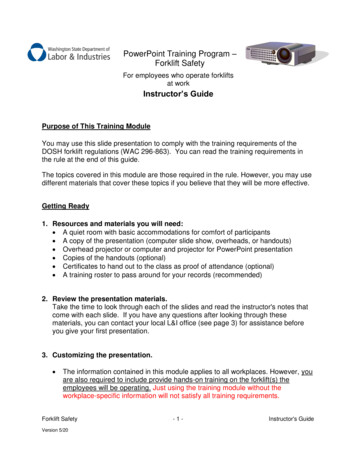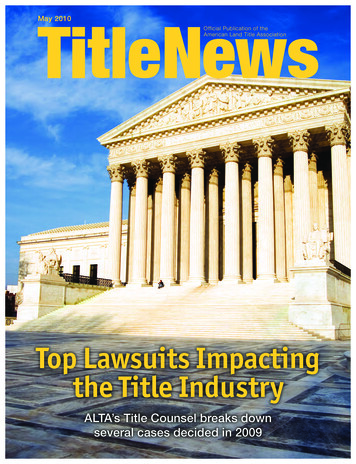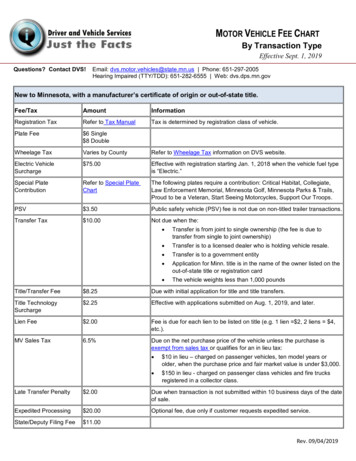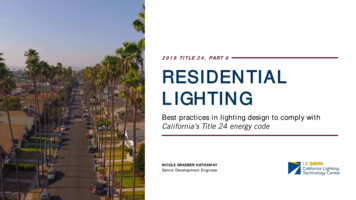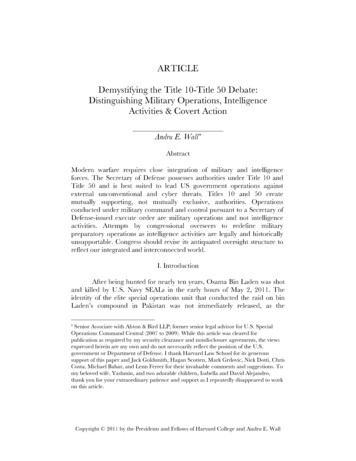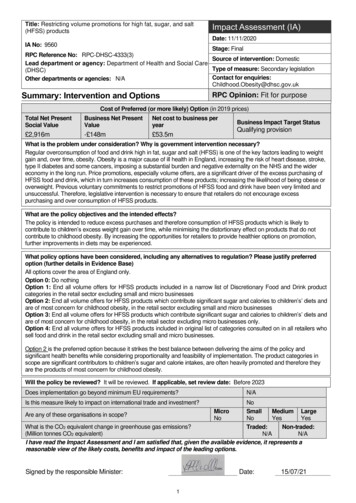
Transcription
Title:Restricting volume promotions for high fat, sugar, and salt (HFSS)productsIA No: 13011Lead department or agency:Department of Health and Social Care (DHSC)Other departments or agencies: n/aImpact Assessment (IA)Date: 16/11/2018Stage: ConsultationSource of intervention: DomesticType of measure: Secondary legislationContact for enquiries:Childhood Obesity TeamEmail: Childhood.Obesity@dh.gsi.gov.ukRPC opinion: Not ApplicableSummary: Intervention and OptionsCost of Preferred (or more likely) Option 3Total Net PresentValueBusiness NetPresent ValueNet cost to business peryear (EANCB on 2014 prices)In scope of One-InThree-Out? 2,940m- 233m 11.7mYesMeasure qualifies asN/AWhat is the problem under consideration? Why is government intervention necessary?Childhood obesity is one of the biggest health problems this country faces. Obesity is a major cause of illhealth in the UK, causing heart disease, stroke, type II diabetes and cancer, imposing a substantial burdenon the NHS. Price promotions, especially volume offers, have been found to cause consumption of high fat,sugar, and salt (HFSS) products above and beyond what would be expected as part of a normal response topricing changes. Government intervention is necessary to ensure that all retailers establish shoppingenvironments that do not encourage excess consumption of HFSS products.What are the policy objectives and the intended effects?The policy is intended to reduce excess purchases of products likely to lead to weight gain while minimisingthe distortionary effect on purchases that do not contribute to obesity. By increasing the likelihood, that storesprovide healthier options on promotion further improvements in diets may be experienced. Mandating acrossthe market ensures that a level playing field is created for businesses.What policy options have been considered, including any alternatives to regulation? Please justifypreferred option (further details in Evidence Base)Option 1: Do nothingOption 2: End all volume offers for HFSS products in all retailers and the out-of-home sector. This wouldinclude free refills of sugar-sweetened beverages (SSBs) that are in scope of the Soft Drinks Industry Levy(SDIL).Option 3: End all volume offers for HFSS products included in Public Health England’s sugar and caloriereduction programme and the SDIL in all retailers who sell food and the out-of-home sector. This wouldinclude free refills of SSBs.Option 4: No more than 20% of sales from volume offers on food and drink per year can come from HFSSproducts included in Public Health England’s sugar and calorie reduction programmes and the SDIL.A preferred option has not been chosen. This choice will be informed by the consultation exercise. For thepurposes of this document only (to aid clarity by comparing against a single option), Option 3 is presented asthe preferred option. Furthermore, as part of the consultation, we are open to alternative suggestions fromstakeholders on the best way to implement this policy to achieve these aims.Will the policy be reviewed? It will be reviewed. If applicable, set review date: before 2023Does implementation go beyond minimum EU requirements?N/AAre any of these organisations in scope? If Micros notMicro 20SmallMedium Largeexempted set out reason in Evidence Base.NoYesYesYesYesWhat is the CO2 equivalent change in greenhouse gas emissions?Traded:Non-traded:(Million tonnes CO2 equivalent)I have read the Impact Assessment and I am satisfied that, given the available evidence, it represents areasonable view of the likely costs, benefits and impact of the leading options.Signed by the responsibleSELECT SIGNATORY:Date:116/11/18
Summary: Analysis & EvidencePolicy Option 1Description: Do nothing/business as usualFULL ECONOMIC ASSESSMENTPrice BaseYearPV BaseYearTime PeriodYearsNet Benefit (Present Value (PV)) ( m)Low: OptionalTotal TransitionCOSTS ( m)(Constant Price)YearsHigh: OptionalBest Estimate:Average AnnualTotal Cost(excl. Transition) (Constant Price)(Present nalOptionalBest EstimateDescription and scale of key monetised costs by ‘main affected groups’These are defined to be 0Other key non-monetised costs by ‘main affected groups’These are defined to be 0Total TransitionBENEFITS ( m)(Constant Price)YearsAverage AnnualTotal Benefit(excl. Transition) (Constant Price)(Present nalOptionalBest EstimateDescription and scale of key monetised benefits by ‘main affected groups’These are defined to be 0Other key non-monetised benefits by ‘main affected groups’These are defined to be 0Key assumptions/sensitivities/risksDiscount rate (%)N/ABUSINESS ASSESSMENT (Option 1)Score for Business Impact Target(qualifying provisions only) m:Direct impact on business (Equivalent Annual) m:Costs:Benefits:Net:2
Summary: Analysis & EvidencePolicy Option 2Description: End all volume offers for HFSS products in all retailers and the out-of-home sector. This wouldinclude free refills of sugar-sweetened beverages that are in scope of the Soft Drinks Industry Levy.FULL ECONOMIC ASSESSMENTPrice BaseYear 2018PV BaseYear 2018COSTS ( m)Time PeriodYears 25Net Benefit (Present Value (PV)) ( m)Low: -30High: 8,670Total Transition(Constant Price)Low5High5Best Estimate5YearsBest Estimate: 5,190Average AnnualTotal Cost(excl. Transition) (Constant Price)(Present Value)Optional30Optional785284801Description and scale of key monetised costs by ‘main affected groups’Over 25 years expected costs include lost retailer profits of around 340m and lost manufacturer profits ofaround 110m. Additional familiarisation and product assessment costs of 3m for the out-of-home sectorand 2m for retailers. The opportunity cost to DHSC of enforcing these regulations is estimated to be around 25m across 25 years.Other key non-monetised costs by ‘main affected groups’A significant reduction in profits for out-of-home businesses and food and drink manufacturers supplyingthis sector.BENEFITS ( m)Total Transition(Constant Price)YearsAverage AnnualTotal Benefit(excl. Transition) (Constant Price)(Present 5Best Estimate5,675Description and scale of key monetised benefits by ‘main affected groups’Expected benefits are the health benefits that would accrue because of lower calorie consumption amongstoverweight and obese people – equivalent to 3.1bn over the 25-year assessment period. There would beadditional health benefits to the population from reinvesting cost savings back into the NHS, worth 2.1bn.Social care benefits would amount to 410m and reduced premature mortality would be expected to deliveran additional 80m of economic output.Other key non-monetised benefits by ‘main affected groups’Consumers may experience an increase in consumer surplus because they no longer have to makeexcessive purchases but can still profit from price cuts.Key assumptions/sensitivities/risksDiscount rate (%)1.5/3.5Key assumptions in the analysis include that retailers switch to using price cuts to promote HFSS products,that this switch reduces prices back down to their average level before these restrictions and that there is adegree of compensatory behaviour. Health benefits require the direct impacts of the intervention not to beoffset and costs to industry are based on limited data on profit margins and a single analytical report. Adiscount rate of 1.5% is applied on health impacts and 3.5% on all other monetised impacts. There arelikely to be various complexities in defining and implementing restrictions on price promotions. Ourconsiderations in the following assume that these are successfully overcome.BUSINESS ASSESSMENT (Option 2)Score for Business Impact Target(qualifying provisions only) m:Direct impact on business (Equivalent Annual) m:Costs: 23Benefits: 0Net: -231153
Summary: Analysis & EvidencePolicy Option 3Description: End all volume offers for HFSS products included in Public Health England’s sugar and caloriereduction programme and the Soft Drinks Industry Levy in retailers and the out-of-home sector. This includesfree refills of sugar-sweetened beverages.FULL ECONOMIC ASSESSMENTPrice BaseYear 2018PV BaseYear 2018COSTS ( m)Time PeriodYears 25Net Benefit (Present Value (PV)) ( m)Low: -30High: 4,920Total Transition(Constant Price)Low5High5Best Estimate5YearsBest Estimate: 2,940Average AnnualTotal Cost(excl. Transition) (Constant Price)(Present Value)Optional30Optional410152551Description and scale of key monetised costs by ‘main affected groups’Over 25 years expected costs include lost retailer profits of around 175m and lost manufacturer profits of 55m. Additional familiarisation and product assessment costs of 3m for the out-of-home sector and 2mfor retailers. The opportunity cost to DHSC of enforcing these regulations is estimated to be around 25m.Other key non-monetised costs by ‘main affected groups’A significant reduction in profits for the out-of-home sector and manufacturers supporting the out-of-homesector. A loss in consumer surplus for consumers who currently make extensive use of price promotions.BENEFITS ( m)Total Transition(Constant Price)YearsAverage AnnualTotal Benefit(excl. Transition) (Constant Price)(Present 5Best Estimate3,200Description and scale of key monetised benefits by ‘main affected groups’Expected benefits are the health benefits that would accrue because of lower calorie consumption amongstoverweight and obese people – equivalent to 1.7bn over the 25-year assessment period. There would beadditional health benefits to the population from reinvesting cost savings back into the NHS, worth 1.2bn.Social care benefits would amount to 230m and reduced premature mortality would be expected to deliveran additional 45m of economic output.Other key non-monetised benefits by ‘main affected groups’Consumers may experience an increase in consumer surplus because they no longer have to makeexcessive purchases but can still profit from price cuts.Key assumptions/sensitivities/risksDiscount rate (%)1.5/3.5Key assumptions in the analysis include that retailers switch to using price cuts to promote HFSS products,that this switch reduces prices back down to their average level before these restrictions and that there is adegree of compensatory behaviour. Health benefits require the direct impacts of the intervention not to beoffset and costs to industry are based on limited data on profit margins and a single analytical report. Adiscount rate of 1.5% is applied on health impacts and 3.5% on all other monetised impacts. There are likelyto be various complexities in defining and implementing restrictions on price promotions. Ourconsiderations in the following assume that these are successfully overcome.BUSINESS ASSESSMENT (Option 3)Score for Business Impact Target(qualifying provisions only) m:Direct impact on business (Equivalent Annual) m:Costs: 12Benefits: 0Net: -12594
Summary: Analysis & EvidencePolicy Option 4Description: No more than 20% of sales from volume offers on food and drink per year can come from HFSSproducts included in Public Health England’s sugar and calorie reduction programmes and the Soft DrinksIndustry Levy.FULL ECONOMIC ASSESSMENTPrice BaseYear 2018PV BaseYear 2018COSTS ( m)Time PeriodYears 25Net Benefit (Present Value (PV)) ( m)Low: -80High: 1,150Total Transition(Constant Price)Low5High5Best Estimate5YearsBest Estimate: 660Average AnnualTotal Cost(excl. Transition) (Constant Price)(Present Value)Optional80Optional17571401Description and scale of key monetised costs by ‘main affected groups’Over 25 years expected costs include lost retailer profits of around 45m and lost manufacturer profits of 15m. Additional familiarisation and product assessment costs of 3m for the out-of-home sector and 2mfor retailers. The cost of monitoring progress against the target is estimated to be around 9m for retailersand 18m for out-of-home businesses over 25 years. The opportunity cost to DHSC of enforcing theseregulations is estimated to be around 48m across 25 years.Other key non-monetised costs by ‘main affected groups’A significant reduction in profits for the out-of-home sector and manufacturers supporting the out-of-homesector. A loss in consumer surplus for consumers who currently make extensive use of price promotions.BENEFITS ( m)Total Transition(Constant Price)YearsAverage AnnualTotal Benefit(excl. Transition) (Constant Price)(Present 0Best Estimate795Description and scale of key monetised benefits by ‘main affected groups’Expected benefits are the health benefits that would accrue because of lower calorie consumption amongstoverweight and obese people – equivalent to 0.4bn over the 25-year assessment period. There would beadditional health benefits to the population from reinvesting cost savings back into the NHS, worth 0.3bn.Social care benefits would amount to 58m and reduced premature mortality would be expected to deliveran additional 11m of economic output.Other key non-monetised benefits by ‘main affected groups’Consumers may experience an increase in consumer surplus because they no longer need to makeexcessive purchases but can still profit from price cuts.Key assumptions/sensitivities/risksDiscount rate (%)1.5/3.5Key assumptions in the analysis include that retailers switch to using price cuts to promote HFSS products,that this switch reduces prices back down to their average level before these restrictions and that there is adegree of compensatory behaviour. Health benefits require the direct impacts of the intervention not to beoffset and costs to industry are based on limited data on profit margins and a single analytical report. Adiscount rate of 1.5% is applied on health impacts and 3.5% on all other monetised impacts. There are likelyto be various complexities in defining and implementing restrictions on price promotions. Ourconsiderations in the following assume that these are successfully overcome.BUSINESS ASSESSMENT (Option 4)Score for Business Impact Target(qualifying provisions only) m:Direct impact on business (Equivalent Annual) m:Costs: 5Benefits: 0Net: -5235
ContentsSummary: Intervention and Options. 1Summary: Analysis & Evidence Policy Option 1 . 2Summary: Analysis & Evidence Policy Option 2 . 3Summary: Analysis & Evidence Policy Option 3 . 4Summary: Analysis & Evidence Policy Option 4 . 5Contents. 6Executive summary . 8Problem under consideration . 10Types of price promotions . 10Rationale for intervention . 11Impact on children . 12Policy objective, context and options . 13Policy objective . 13Policy context . 13Policy Options . 15Option 1 – Do nothing . 16Option 2 – End all volume offers for HFSS products in retailers and the out-of-homesector. Including free refills of sugar-sweetened beverages. . 16Option 3 – End all volume offers for HFSS products included in Public Health England’ssugar and calorie reduction programmes and the SDIL in retailers and the out-of-homesector. . 17Option 4 – No more than 20% of sales from volume offers on food and drink per yearcome from HFSS products included in Public Health England’s sugar and caloriereduction programmes and the SDIL. 17Alternative Options Considered . 18List of proposed exclusions . 18Impact of promotions on sales and profits. 19Impact of price cuts and multi-buy promotions on sales . 19Impact of promotions on manufacturer and retailer profits . 22Current composition of the market . 23Composition of the food retail market . 23Composition of the out-of-home sector . 25Costs and benefits of options . 26Option 1 – Do nothing. 26Option 2 - End all volume offers of high fat, sugar, and salt (HFSS) products in all retailerswho sell food and the out-of-home sector. 26Costs to retailers . 26Costs to the out-of-home sector . 33Costs to Manufacturers . 35Costs to Government . 376
Consumers . 38Summary of costs and benefits . 43Option 3 - End all volume offers for HFSS products included in Public Health England’s sugarand calorie reduction programme and the Soft Drinks Industry Levy (SDIL) . 45Costs to Retailers and Manufacturers . 45Costs to the out-of-home sector . 45Reformulation . 46Costs to Government . 46Consumers . 46Summary of costs and benefits . 48Option 4 - No more than 20% of sales from volume offers on food and drink per year comefrom HFSS products included in Public Health England’s sugar and calorie reductionprogrammes and the SDIL . 49Costs to Retailers and Manufacturers . 49Costs to the out-of-home sector . 51Reformulation . 52Costs to Government . 52Consumers . 53Summary of costs and benefits . 55One-in-three-out calculation . 56Sensitivity and risk analysis . 56Interaction of policy effects . 56Critical value analysis . 56Sensitivity analysis . 57Specific Impact Tests . 59Small and Micro Business Assessment . 59Equality Test. 60Inequality Test . 60Competition Test . 62Sustainability Test . 63Environmental Test . 63Justice Impact Test. 63Rural Proofing . 63Human Rights Assessment . 63Annexes . 64Annex A – DHSC Calorie Model. 64Annex B – HFSS Definition . 65Annex C – Questions for consultation . 67Annex D – Products included in the Soft Drinks Industry Levy and the Calorie and SugarReduction Programmes . 687
Executive summaryProblem and justification for action1. Childhood obesity is one of the biggest health problems this country faces. Nearly a quarter of childrenin England are obese or overweight by the time they start primary school aged five, and this rises toone third by the time they leave aged 11 1.2. Obesity is a major determinant of ill health 2. This imposes a substantial burden on the NHS, withoverweight and obesity costing the health service in England 5.1bn in 2014/15 3. Obesity causesfurther costs to society through premature mortality, increased sickness absence and additional benefitpayments.3. Price promotions (volume promotions and temporary price cuts) in the UK are the highest in Europe.They account for around 40% of take home food and drink expenditure. Furthermore, higher sugarfood and drink items are more likely to be promoted and deeply promoted 4. Government interventionis necessary to ensure businesses establish shopping environments that do not encourage excesscalorie consumption.Policy objective4. This impact assessment includes modelling of a range of options. Through this modelling weestablished the two best options to pursue and seek stakeholders views on (Option 3 and Option 4 inthis document). The options analysed in the IA are: Option 1: Do nothingOption 2: End all volume offers of high fat, sugar, and salt (HFSS) products in all retailers whosell food and the out-of-home sector. This would include free refills of sugar-sweetenedbeverages (SSBs), provided they are in scope of the Soft Drinks Industry levy.Option 3: End all volume offers for HFSS products included in Public Health England’s (PHE)sugar and calorie reduction programme and the Soft Drinks Industry Levy (SDIL) in all retailerswho sell food and the out-of-home sector.Option 4: No more than 20% of sales from volume offers on food and drink per year can comefrom HFSS products included in PHEs sugar and calorie reduction programmes and the SDIL.5. A preferred option has not been chosen. This choice will be informed by the consultation exercise. Forthe purposes of this document only (to aid clarity by contrasting against a single option), Option 3 ispresented as the preferred option. It is helpful to point out that Option 3 is better targeted at the productsthat contribute the most sugar and calories to children’s diets than Option 2 and delivers more benefitsthan Option 4.Costs and benefits of options6. The benefits from restricting the promotion of HFSS products are expected to be a reduction in obesityprevalence and obesity related morbidity and mortality.7. The main categories of costs are transition costs associated with checking products and lost profits toindustry due to reduced sales of HFSS products.8. The figures presented below are taken from our central estimates, which assume that compensatingbehaviour by consumers and industry means that 40% of the calories removed from people’s diets arereplaced. High and low estimates based on different levels of calorie compensation are included in thecost and benefit of options section in the main text.1NHS Digital (2017) National Child Measurement Programme 2016/172Guh et al. (2009) The incidence of co-morbidities related to obesity and overweight: A systematic review and meta-analysis, BMC PublicHealth3Estimates for UK in 2014/15 are based on: Scarborough, P. (2011) The economic burden of ill health due to diet, physical inactivity, smoking,alcohol and obesity in the UK: an update to 2006–07 NHS costs. Journal of Public Health. May 2011, 1-9. Uplifted to take into account inflation.No adjustment has been made for slight changes in overweight and obesity rates over this period. We assume England costs account foraround 85% of UK costs.4Public Health England (2015) Sugar reduction: the evidence for action, available oads/attachment data/file/470179/Sugar reduction The evidence for action.pdf(Accessed 15/06/2018)8
Illustrative Preferred Option9. Option 3 has been presented as the preferred option for the purposes of this document, though theconsultation process will seek evidence to inform the final choice of options.10. Our central estimates of the total net present value of costs to government and industry are around 255m. This is compared to total benefits of around 3.2bn. Over 25 years, expected costs to retailersinclude total transition costs of 2m and lost profit of approximately 1175m. Costs to out-of-homesector businesses include transition costs of 3m and an unquantified reduction in profit. Over thisperiod, manufacturers of HFSS products would also experience total lost profits of around 55m.11. The enforcement costs will be borne by the Department of Health and Social Care. The opportunitycost to the department of enforcing these regulations is estimated to be around 25m across 25 years.12. The expected health benefits for Option 3 are estimated to be around 1.7bn over the 25-yearassessment period. Reduced morbidity would also result in reduced cost pressures to the NHS. Therewould be additional health benefits to the population from reinvesting these savings back into the NHS,these are estimated to be worth around 1.2bn. Social care savings would amount to 230m andreduced premature mortality would be expected to deliver an additional 45m economic output throughadditional labour force participation.Alternative OptionsOption 213. The difference between Option 2 and 3 is that here all HFSS products would be banned from volumeoffers, not just those included in Public Health England’s reformulation programmes and the SDIL. Thetotal costs for this option are estimated to be 480m and total benefits 5.7bn over the 25-yearassessment period.Option 414. Under Option 4, retailers and out-of-home food outlets would be required to ensure that no more than20% of their sales from volu
Price promotions, especially volume offers, have been found to cause consumption of high fat, sugar, and salt (HFSS) products above and beyond what would be expected as part of a normal response to pricing changes. Government intervention is necessary ensure that all retailers establish shopping to . Key assumptions in the analysis include .
